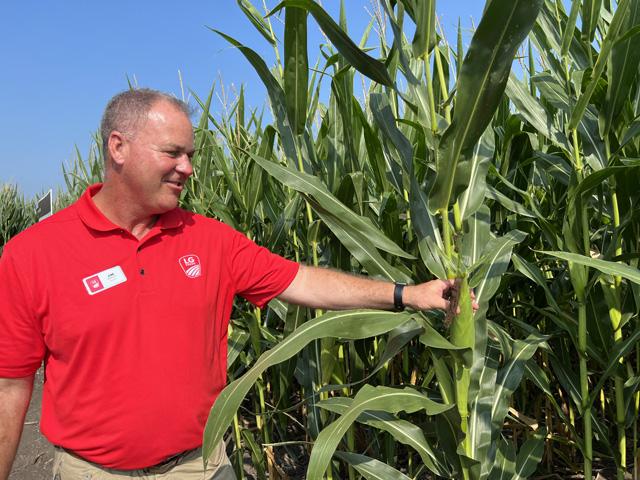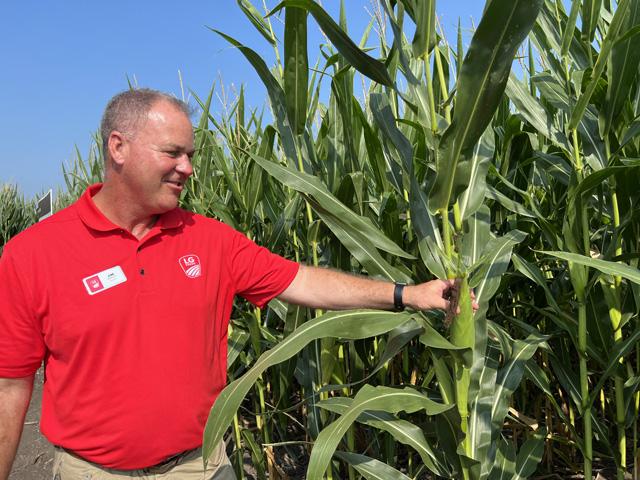Production Blog
Variable Crop Makes 2023 Corn Yield Estimates Tricky
IVESDALE, Ill. (DTN) -- Predicting the corn crop in August has become almost as competitive as basketball brackets during the madness of March. This time of year, USDA numbers and organized field tour estimates combine with social media sniping to create harvest anticipation that seems to get more animated each year.
The weather uncertainties thrown at the current crop are adding another twist in 2023. Not only do regions of the country tend to vary when it comes to crop condition this season, but field-by-field and in-field variability is causing more uncertainty.
Jim Rowley, a certified professional agronomist and technical sales agronomist for LG Seeds, based in Peoria, Illinois, told DTN during a recent field day that this variability is one of many reasons to check fields this time of year. You can get a measure of potential yield, but it also helps to assess maturity levels, lurking harvest problems and storage needs.
"It's been a stressful year on the crop due to dry conditions, but what's really unique about this year is those rains changed how the corn plant grew and developed," said Rowley. Not every region of the country is the same, of course, but the Illinois territory Rowley covers received rains immediately after planting and then went without moisture until VT stage or just prior to pollination.
Rowley said this long period without a drink caused the corn plant to naturally deploy what is called "partitioning" or allocating of resources.
"In a drought year like this one, the plant partitioned its nutrients, water and assimilates to the roots. This focus on root growth is called the shoot-to-root relationship," he explained. "Because of that allocation, we saw many plants grow shorter than normal this year."
You may have also noticed that uneven corn growth within some fields this year. Rowley said that not all hybrids partition resources the same and this was obvious in fields where blended seed was planted.
To delay insect resistance to Bt traits, seed companies blend a percentage of non-traited seed into each bag. Farmers know this as refuge-in-a-bag, or RIB, seed blends and seed companies try to match these two hybrids so they grow and mature at the same rate.
"We saw cases this year where the refuge hybrids were noticeably taller than the base hybrid," Rowley said. "We don't normally see that until this partitioning takes place and the two hybrids react differently."
KERNEL WEIGHT MATTERS
Due to drought conditions, Rowley said much of the corn crop came through July behind in development. "Since the rains in early August, the reproductive stage accelerated, and it has taken us through dough stage very rapidly.
P[L1] D[0x0] M[300x250] OOP[F] ADUNIT[] T[]
"A lot of locations in central Illinois are now at dent stage, which means starch accumulation is coming to a halt as we near physiological maturity (black layer of R6). In those situations where the reproductive season has been compressed, we could see slightly lower top end yield and there is a potential of lower test weights," he added.
Those kernel weights aren't always factored into the formulas used to do early yield estimates, but they matter, Rowley said. "Some will divide by a factor or 90 and others go as low as 70 if kernels are large -- so it's a little arbitrary as to what is used to come up with estimates," he added.
The closer to maturation, the less guessing there is regarding kernel depth and weight.
YIELD ESTIMATE FORMULAS
Been following all the recent yield tours and thinking "no way" those estimates are real? There are several simple formulas to use to do your own yield checks. A DTN article that delves into the different calculations can be found here: https://www.dtnpf.com/….
A recent news release by University of Illinois agronomists Giovoni Preza-Fontes and Emerson Nafziger gives a simple formula. What you are trying to get to is how many kernels there are per acre. "With most cornfields in Illinois at the dough (R4) or dent (R5) stage, kernel numbers are fixed, leaving only the accuracy of kernel counts and guesses of final kernel weight as the only sources of variation in estimating yields," they wrote.
The Illinois agronomists give this three-step formula for estimating yields prior to harvest:
1. Count the number of ears per acre -- usually in 1/1000th of an acre (17.4 feet of row in 30-inch rows). If second ears on a plant have kernels, second ears should be included (counting as one ear for that plant.)
2. Pull three or four ears from the section of row used for the ear count, count the number of rows and kernels per row on each ear, then multiply these to get kernels per ear. Average the number of kernels per ear, then multiply that average times the number of ears in the 1/1000th of an acre to calculate the number of kernels per 1/1000th of an acre. For example, a field with 34 ears per 1/1000th acre and an average of 560 kernels per ear has 19,040 kernels in 1/1000th of an acre.
3. The final step is to divide the kernels per 1/1000th of an acre by the expected (guessed-at) kernel weight per 1/1000th of a bushel. Under typical grain-filling conditions, we can expect about 80,000 kernels per bushel, so this number would be 80. In this example, dividing 19,040 by 80 gives 238 bushels per acre (bpa).
Under highly favorable conditions during grain-filling, kernels may get larger than normal, and there may be 75,000 or fewer kernels per bushel. In contrast, kernels per bushel may be 90,000 or 95,000 in a drought year. A change from 80 to 95 kernels per 1/1000th of a bushel in our example (19,040 kernels per 1,000th of an acre), corresponds to a yield drop from 238 to 200 bpa.
Find the Aug. 18, 2023, release titled "The 2023 Corn Crop as the Season Winds Down" here: https://farmdoc.illinois.edu/….
EYES ON EARS
The variability in the crop this year is reason enough to get into the field and pull ears prior to harvest this year, Rowley said. Pollination wasn't an issue in his territory, but there have been reports of problems elsewhere.
"Overall, the crop seems healthy with much less crown rot and other early disease pressures, but there are susceptible fields that still had pathogens. Those may need to be prioritized for harvest if they are deteriorating," Rowley said.
Yes, extreme heat stresses the crop. "But this year we mostly made it through pollination before it hit. And, as long as there's adequate water and we're below 95 degrees, the plant will handle it," Rowley said.
It's when temperatures exceed 95 Fahrenheit and water is restricted that the plant can't keep up and it will accelerate the senescence of the crop, he explained.
"When it comes to yield, it's photosynthesis versus respiration. Daytime photosynthesis adds dry weight. Nighttime respiration reduces dry weight. Cool nights allow for quicker respiration and less loss of dry weight. Warmer nights require longer respiration and correspondingly more loss of dry weight.
"This year we've been fortunate because the cooler nights have helped salvage some of the crop," Rowley added.
Pamela Smith can be reached at pamela.smith@dtn.com
Follow her on X, formerly known as Twitter, @PamSmithDTN
(c) Copyright 2023 DTN, LLC. All rights reserved.






Comments
To comment, please Log In or Join our Community .